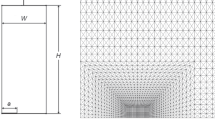Abstract
A finite element method for linear elastic fracture mechanics using enriched quadratic interpolations is presented. The quadratic finite elements are enriched with the asymptotic near tip displacement solutions and the Heaviside function so that the finite element approximation is capable of resolving the singular stress field at the crack tip as well as the jump in the displacement field across the crack face without any significant mesh refinement. The geometry of the crack is represented by a level set function which is interpolated on the same quadratic finite element discretization. Due to the higher-order approximation for the crack description we are able to represent a crack with curvature. The method is verified on several examples and comparisons are made to similar formulations using linear interpolants.
Similar content being viewed by others
Author information
Authors and Affiliations
Additional information
Dedicated to the memory of Prof. Mike Crisfield, for his cheerfulness and cooperation as a challenge and friend over many years.
The authors are grateful for the research support by the Office of Naval Research. This work was supported in part under the auspices of the U.S. Department of Energy by the University of California, Lawrence Livermore National Laboratory under Contract No. W-74055-Eng-48. Furio Lorenzo Stazi is grateful for the research support of the Fulbright Fellowship.
Rights and permissions
About this article
Cite this article
Stazi, F., Budyn, E., Chessa, J. et al. An extended finite element method with higher-order elements for curved cracks. Computational Mechanics 31, 38–48 (2003). https://doi.org/10.1007/s00466-002-0391-2
Issue Date:
DOI: https://doi.org/10.1007/s00466-002-0391-2




